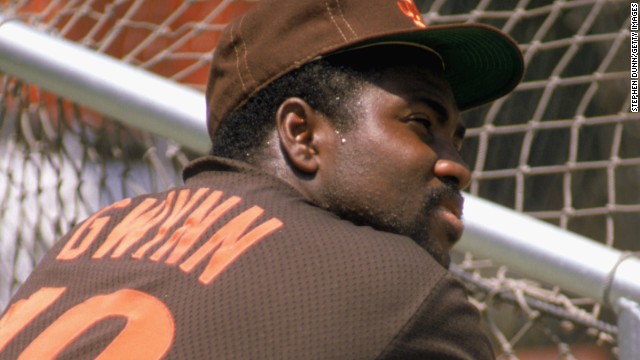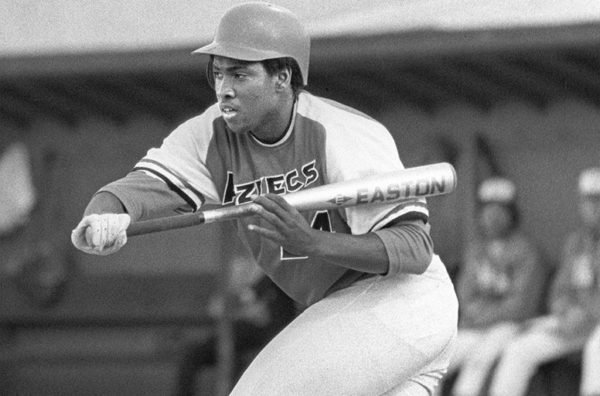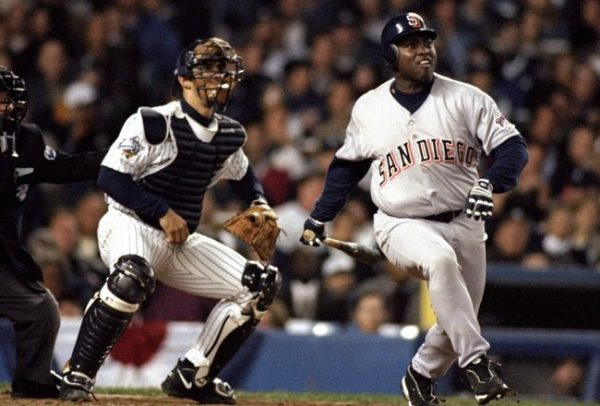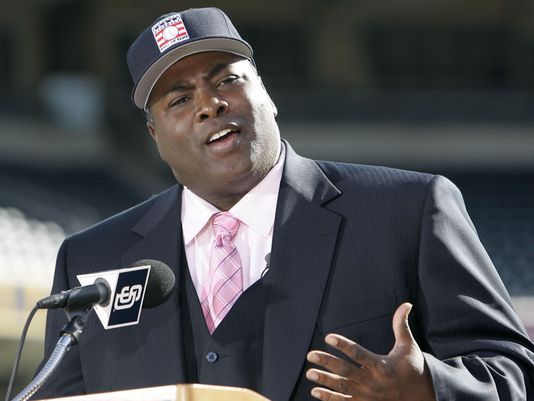One Team, One Town, One of a Kind–Tony Gwynn

Credit: AP Photo

The heartbreaking news spread quickly that Monday morning.
On June 16, 2014, Anthony Keith Gwynn, San Diego’s beloved Mr. Padre, lost his battle against cancer at the age of 54. Outpourings of grief rocked the baseball world for the player and for the man. On Saturday, May 9 this year, MLB Network devoted 12 hours to a Tony Gwynn marathon on the day he would have turned 60.
There will never be another Tony Gwynn, not in San Diego, not in all of baseball.
He played for one team in one town. Sure he could have earned more money and more fame with another team in another town. But Gwynn, the best pure hitter of his generation, chose to stay here. San Diego fans will always love him for that, but for much more too.
Only by chance did Gwynn become a baseball player. He attended San Diego State (now San Diego State University) on a basketball scholarship. Coach Jim Dietz talked him into joining the team, but Gwynn insisted on finishing the basketball season before picking up a bat.
Gwynn hadn’t been considered a top talent in 1981, the year the Padres drafted him. In fact, Jack McKeon, the general manager at the time, hadn’t even heard of Gwynn until he attended an exhibition game between the Padres and SDS. He noticed a left-handed batter driving the ball to all fields and learned that he had joined the team just five days earlier.
Still, thanks to disagreements in the draft room, Gwynn fell to the third round, 58th overall. Later that day, the San Diego Clippers also drafted Gwynn in the 10th round.
Fortunately, Gwynn chose baseball and started his minor league career. In 1983, an injured wrist kept him on the bench, and when he returned, he saw his average fall to the low .200s. Searching for answers to his slump, he asked his wife, Alicia, to start recording his plate appearances so he could study his swing. Thus, video review became part of his routine long before it became the norm. Granted, Gwynn had been gifted with extraordinary hand-eye coordination, but he worked tirelessly to hone his craft.

In 1984, Gwynn played his first full season with the Padres–a year in which the Padres won their first National League West title and went on to the World Series but lost to the Detroit Tigers. During the offseason, Gwynn signed a six-year contract rather than testing the waters elsewhere.
Despite becoming the first NL player since Stan Musial to win three batting titles in a row by 1989, six other players on the team made more than Gwynn by that time. The following season, teammates like Jack Clark complained about Gwynn’s “selfishness” to the media, criticisms which obviously hurt. And then he injured his left knee, which would be drained a painful seven times until he resorted to surgery. After the season, his father Charles, just 57, died of a heart attack, and Gwynn even considered quitting baseball.
But after two knee surgeries, Gwynn began the 1993 season with more confidence. By then, he had sought out another master at hitting, Ted Williams, beginning a close relationship.
Gwynn batted a gaudy .358 that year, but the Padres lost 101 games. Andres Galarraga (.370) won the batting title thanks to the launching pad the expansion Colorado Rockies call home.
The following year, a relatively healthy Gwynn hit .383 before the All-Star break, but by then, strike talk had overtaken the league. In the 28 games of the shortened second half, Gwynn hit .423, and his average skyrocketed to .475 during the ten games before the players struck. He never expressed bitterness over the lost opportunity, but he did believe that 1994 would have been his year to match Williams, the last player to hit .400.
However, Gwynn did reach two other historic milestones. On August 6, 1999, he hit four singles and joined the three-thousand hit club at Olympic Stadium in Montreal. That just happened to be the anniversary of his 2,000th hit six years earlier, and both occurred on the birthday of his mother, Vandella.

But his favorite hit occurred during the 1998 World Series against the New York Yankee’s David Wells. Gwynn homered off the second deck Yankee Stadium in the first game. Unfortunately, the Padres couldn’t match one of the best teams ever assembled. In the series, Gwynn batted .500 (8-16), his teammates .203.
Of course, the Padres haven’t reached the World Series since then, but fans could still enjoy watching Gwynn, who didn’t retire until October 7, 2001, a late end to the season because of the terrorist attacks that September. He had announced his retirement in June that year, and fans gave him standing ovations in every stadium on the Padres’ schedule. In his 20th season, he averaged .324 in 112 plate appearances.
During his career, Gwynn won eight batting titles. From 1983 to 2000, he hit at least .300, second to Ty Cobb’s 23 seasons. Only Ted Williams’ .344 career average exceeds Gwynn’s .338. At 37, he reached his highest hit total–220.
Not a great defender at the beginning of his career, Gwynn also worked hard to improve in right field. By the end of his career, he’d received five Gold Gloves and appeared in 15 All-Star games.
At a time when strikeouts have become routine, the fact that Gwynn struck out three times in one measly game his entire career boggles the mind. In fact, he never struck out against the aces of his era Greg Maddux (94 ABs) and Pedro Martinez (135 ABs). During his career, he had a 4.2 percent strikeout rate at a time when the ML average was 15.4 percent. To put that into perspective, last year, batters struck out 23 percent of plate appearances. In fact, the strikeout rate has increased in 11 or the past 12 seasons.
The Padres retired Gwynn’s number 19 in 2004, and he took his rightful place in baseball’s Hall of Fame in 2007 with fellow first-ballot selection Cal Ripkin Jr. In his speech in Cooperstown, New York, Gwynn spoke from the heart.
I’m proud as heck to be a San Diego Padre. I played for one team. I played in one town. I told the people of San Diego when I left to come to Cooperstown, they were going to be standing up here with me, so I hope they are just as nervous as I am because this is a tremendous honor to be here today.
Just as Gwynn could have signed with another team for more money, he could have had a second career in television but chose to coach the baseball team at his alma mater. He actually replaced his manager, Jim Dietz. John Moores, the owner of the Padres from 1995 until 2012, donated around $30 million for athletic facilities at SDSU, including a new baseball park named after Gwynn.

“People in San Diego are never going to see anybody like that again,” Moores told Barry Bloom of mlb.com on June 16, 2014. “It’s impossible. It will never happen. Not in 10 lifetimes. He was a special player, but it’s more than that. It was the dedication. He just did what he wanted to do. That was the way he lived. Whether right or wrong, he did it on his own terms. He wasn’t interested in the money. He wanted to stay in San Diego. He wanted to live a certain way, and he did.”
In Poway, where Gwynn lived with his wife Alicia and children, Anisha and Tony Jr., Gwynn didn’t act like a superstar. He acted like an ordinary guy who said hi to everyone he encountered. And that laugh… It was infectious. On the job, he’d patiently signed balls, especially those held out by grubby little hands.
Given the opportunity, Gwynn would probably be still coaching college baseball. But in 2009, he revealed that he’d been diagnosed with salivary gland cancer, most probably caused by chewing tobacco. He believed he’d beaten cancer after his first surgery. But it returned in 2012. After undergoing radiation treatment and surgery, which lasted 13 hours, he said he was just happy to be alive when he woke up in the hospital.
[wpedon id=”49075″ align=”right”]
Tragically cancer ultimately won the battle, and fans all over San Diego and the baseball world joined his family in mourning Anthony Keith Gwynn. A bronze sculpture stands on a grassy hill just outside Petco Park. Fans from all over the county gathered there to mourn when they heard the news, leaving behind flowers, baseball memorabilia, and notes.
The Padres may not have a World Series Trophy or a storied history, but knowing that Tony Gwynn chose San Diego over the almighty dollar and worked his magic with a bat and a laugh for 20 years more than makes up for it.
Baseball has been a part of Diane’s life since her father played professionally (mostly at the minor league level). She has written for a number of publications and concentrated on companion animal welfare. She welcomes the opportunity to write about the sport she loves. Diane shares her home with her husband and a house full of rescued animals.
That might be one of your best writings Diane, if not your best.
What a wonderful capture of Mr. Padre. The first thing I’d do, if I wasn’t watching or listening to the game, was to wake each morning and crack open the SDUT to see how Gwynn did the night before. To check the MLB leaders to see where he stood. We expected the Padres to lose most seasons. We also expected Tony to go 2-4 or 2-5 each night.
You captured who Tony was wonderfully. You brought tears to my eyes and memories to the forefront of my thoughts… thank you.
Now you brought tears to my eyes, Tony C,
You have no idea how much your comment means to me. We Padres fans have been a long-suffering bunch. But we had Tony Gwynn, and there will never be another player like him. Thanks so much!
Diane